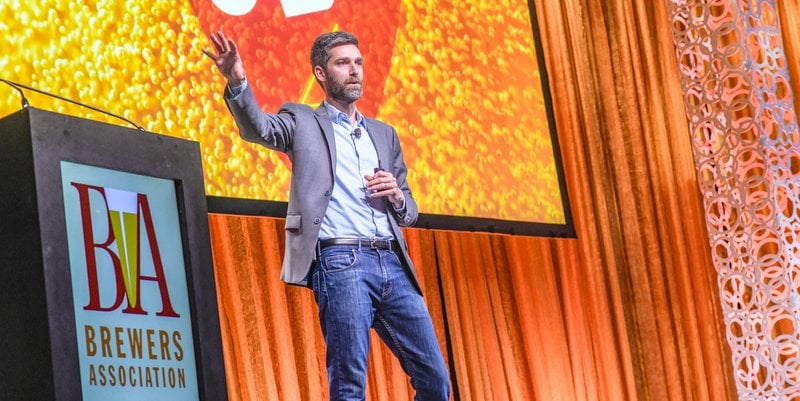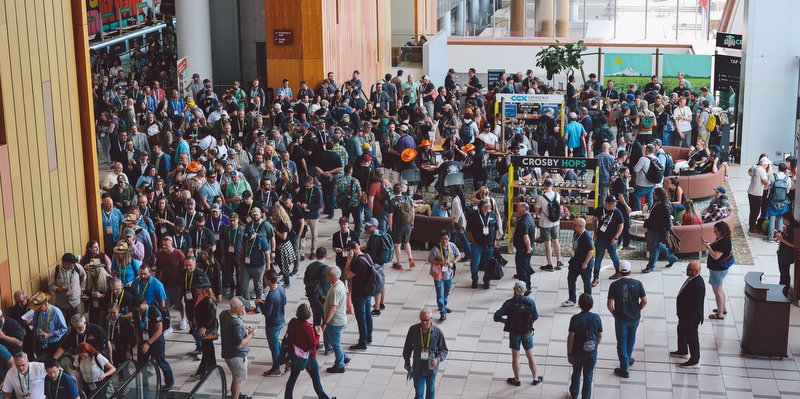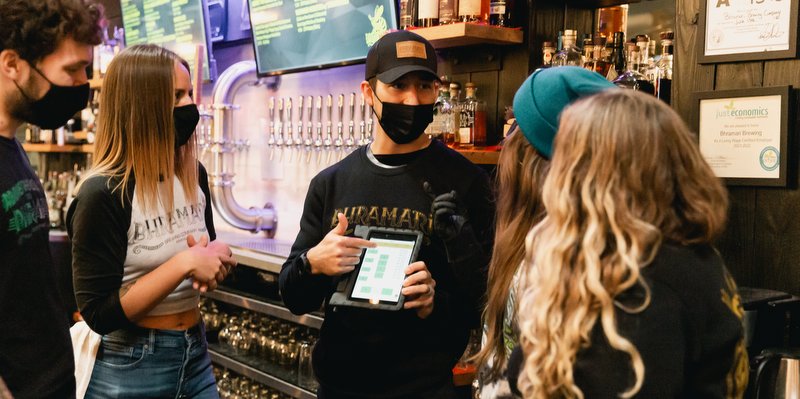
Chief Economist of the Brewers Association Bart Watson delivered a somber statistical overview to kick off the 2023 Craft Brewers Conference & BrewEXPO. Beer sales are down / flat. Closings are on the rise while openings are slowing. Watson considers none of this to be anomalous, calling it firmly the “new normal.”
“We can’t continue to crush the odds,” Watson said.
But that’s probably a good thing. The craft beer industry’s new normal follows a decade of what Watson called “abnormal,” when compared to historic small business success rates. For example, about 76 percent of breweries that opened in 2015 are still open today, vs. the 40 percent chance of any other small business surviving over that same period.
Luckily, there is wiggle room between odds-crushing and sky-is-falling. How do you find your path there? Reflecting on these notes and key quotes from last week’s Craft Beer Conference is a good start …
Focus on what you can grow

When reading the hop leaves of the market – beer is down, seltzer is down, but the flavored malt beverage category as a whole is way up – one can surmise that breweries should continue to innovate and explore new categories and flavor combinations as they did in beer. And as Watson notes, those customers “overlap with craft more than we realize.”
That’s certainly one direction. But then again, chasing trends isn’t necessarily a great plan either. “No one was chasing style trends back in the day,” Watson notes.
Which is true to an extent — but then again – how far back in the day are we talking? Not all of these odds-crushing 9,000+ breweries opened with a unique style and vision. Some opened and found success for a bit because craft beer became trendy, right?
But if looks like craft beer is less trendy in this new normal, which type of brewery is in a better spot? One that quickly jumps on new trends? Or a brand that always follows the boil of its own tanks?
I think this was the best way to answer that, per Watson: “Focus less on what’s growing, and more on what you can grow.”
Disrupting distribution
As Bob Pease, president and CEO of the Brewers Association, reiterated in the CEO panel that followed Watson’s presentation: “We win on-premise with draft. It is a point of differentiation for us.”
So, for those who believe in that sentiment, how can you breathe new life into an account to sell more draft beer?
“If your brand is relevant, and your product is something people want, they are going to demand that product,” stated Craig Purser, president and CEO of the National Beer Wholesalers Association (NBWA), noting the variance in scale depending on the brewery. “Some of you guys have done a tremendous job of owning your marketplace. Some of you might own your neighborhood. What can you do to take that relevance and export it to differentiate yourself while also maintaining focus and not getting ahead of yourself and creating too many varietals?”
A problem here is the businesses Purser represents are constantly consolidating, leaving fewer partners to provide a path to market for more breweries than ever. Tough to influence customers with marketing if you can’t get in front of them in the first place..
Another conundrum on the distribution side of things: The craft portion of many distributors’ portfolios only existed because of that aforementioned trend chasing. Customers were hot for new beer brands. Is that still true? Judging by the Beer Purchasing Index the last 12 months, it is not.
Breweries should not give up on draft beer – the most sustainable way to ship the freshest, local product – as Pease mentioned. But if beer is losing its cultural capital in general, while wholesalers are consolidating and rallying the wagons around its biggest brands, how many breweries can truly capitalize on that point of differentiation?
Can we get more craft-focused distributors in this climate? Purser didn’t have an answer, but Pease tossed out the idea of jump-starting a working group collab with the NBWA.
The most likely answer falls on each brewery or collective of local breweries, in the states that allow it, with a renewed focus on self-distribution. Craft still wins by being engaged / engrained in its community – that is truly its point of differentiation. Brainstorm some new places to sell your beer and some ways to reinvigorating old sales channels.
Less stag and more nation

As a note to end on: Maybe beer is stagnant because not enough types of people identify with beer. The 30 to 55 white male demographic could only take the craft beer industry so far without yielding diminishing returns at some point in time.
Maybe the path out of stagnation is less “stag” and more “nation.” Women, people of color, younger generations, men without beards, and so on – anyone who might not currently identify as a beer drinker could be a future beer drinker (or supporter of your business) with a new approach to sales, marketing, hiring and community-building. This new National Black Brewers Association is also a good start.
The craft beer industry blazed an abnormal trail to get to this place – a place now derisively called the “new normal.” Time to get abnormal again.





Leave a Reply
You must be logged in to post a comment.